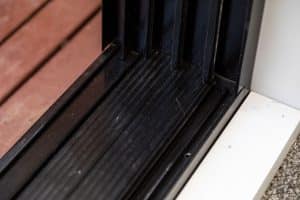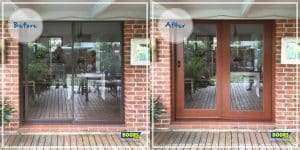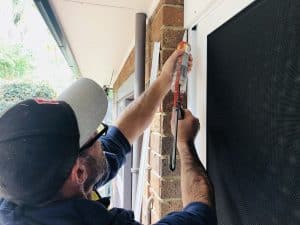How to Insulate Sliding Doors: A Guide to Different Methods

The various styles and types of sliding doors offer many great benefits for your home and family, but insulation can sometimes be a sticking point.
This is particularly true for large glass patio doors that connect your internal and external living areas.

If your doors are old or weathered they are also more likely to be guilty of letting the heat escape.
This not only makes for a draughty home, but it can hit your energy bills hard.
The government has suggested that 40-70% of winter heat loss in Australian homes is through walls, windows and air leakage (https://www.yourhome.gov.au/passive-design/insulation).
Improving the insulation performance of your sliding doors could go a long way towards reining this in – particularly when it comes to external glass doors and “movable wall” sliding doors. But if you don’t know how to insulate sliding doors, where do you start?
Here, we will let you in on some insulation insights from the experts – from simple maintenance tips that can improve the insulation of your sliding door, to specialised products that can be added to your doors.
Find out how to insulate sliding glass doors for winter or discover some new sliding door solutions for a full upgrade.
Practices That Can Improve the Insulation of Your Door
When it comes to the question of how to insulate sliding doors, the good news is that you don’t necessarily need to embark on a major home renovation to feel the impact. There are certain things you can do on a semi-regular basis to keep your sliding doors performing at their best.
-
Vacuuming the Rail to Prevent Gaps
It’s easy for dirt or grit to accumulate in the sliding track over time. Regularly cleaning and maintaining the rail and rollers will help your door to run smoothly and seal properly, preventing heat loss and leaks. The quickest and easiest way to do this is with a small vacuum head that can fit into the track and clear it out.

-
Replacing the Caulking
Caulking around the frames of your doors helps to seal them against the elements, but this does deteriorate over time. Check your sliding door seal, remove any damaged caulk, and replace it using a caulking gun. Choosing a high quality sealant should ensure that you only need to do this every few years.
Products That Can Help Insulate Your Sliding Door
As well as these good general maintenance practices, there are other things you can do to boost the insulation performance of your existing sliding doors without breaking the bank.
DIY options for how to make a sliding door better insulated include:
-
Thermal Curtains
Adding thick, insulated curtains or cellular blinds to the inside of your sliding doors is a great way of keeping the heat in and creating a cosy, homely atmosphere. Be sure to go for heavy, thermal curtains rather than regular curtains, to get the best results.

-
Weather Proofing Strips
Replacing or adding weather proofing strips is a great solution for how to insulate sliding glass doors. This is easy to do yourself and is an effective way of keeping out draughts and moisture. Like caulking, sliding door weather stripping can deteriorate over time so it could make all the difference to refresh yours today.

-
Plastic Window Film
For a quick and cost-effective solution, you can buy a complete window film kit. Simply cut the plastic sheet to size, attach it to the glass pane using the double-sided tape, and then use a hairdryer to seal it. The plastic polymer will shrink and compress when exposed to heat, and this creates an effective barrier against heat loss through the glass doors.

Image Courtesy: todayshomeowner.com
Is Nothing Working? You May Need a New Sliding Door.
Now you know how to insulate sliding doors with some budget-friendly DIY solutions, but if you’re still experiencing draughts and heat loss you may need to think bigger.
If your existing sliding doors are old and tired, it may be time to replace the whole unit.
It’s not unusual for doors and frames to shift over time, which can affect the seal, and if your framework has deteriorated this will also contribute to heat loss and poor insulation performance.

Modern sliding door units, using high grade materials, tend to provide better insulation than older products so it may be worth the up front investment to get some new doors that will last for years to come.
The Doors Plus Bona Vista range uses resilient aluminium frames and laminated glass, while our Panoramic range uses high quality Pacific Ash timber.

Our exclusive SafeGlass is heat treated to be 500% stronger than ordinary glass, making it ideal for external sliding glass doors.
These collections, along with our extensive internal door options, are available in a full range of sliding doors sizes to suit your space.
If you have the budget and the time, there’s no denying that new framework and a set of modern sliding doors, installed by a professional, are guaranteed to deliver the best results when it comes to insulation performance.
Enjoy a Cosier Home With Improved Sliding Door Insulation
Knowing how to insulate sliding doors, with quick fixes and longer term solutions, is key to maintaining a comfortable and cosy living environment.
You’re sure to feel the difference, and to appreciate the energy savings too!
If you’re still struggling with heat loss and draughts through your sliding doors, especially in the winter months, you might just find the answer to your problems at your local Doors Plus showroom.
Visit us for a personal consultation with one of our friendly door experts and discover your options.
We can help you understand the pros and cons of different materials, styles and upgrades, and the relative cost of sliding doors, so that you can make an informed decision.
We’re here to help you enjoy your home through every season.











